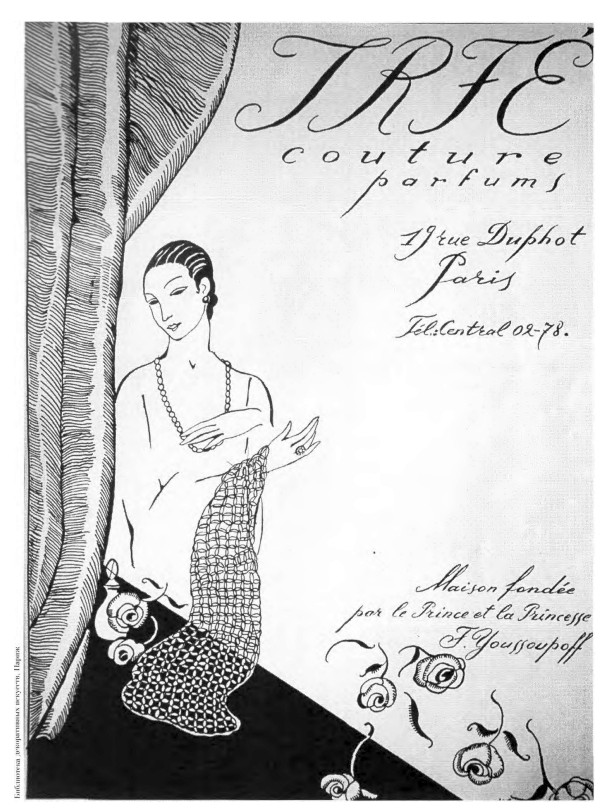We are publishing chapters from the book by fashion historian Alexandre Vassiliev "Beauty in Exile", dedicated to the fashion house IRFE, Part 1.
The Russian fashion house Irfe was established in Paris in 1924 and lasted until 1931. Its founders and designers were Princess Irina Romanova and Prince Felix Youssoupoff (the French spelling of “Yusupov”), who created the name “Irfe” from the first two letters of their first names. The princely family of Youssoupoff was a distinguished, old noble family in Russia, descended from Abubekir-benRaioc, a descendant of the prophet Ali and nephew of Mohammed, who held the title of Emir el Omar. His successor, Termess, migrated from Arabia to the Caspian shore. His heir, Edigei Mangit, who took part in the campaigns of Tamerlane, moved to the Black Sea coast and established a Crimean khanate there. The descendant of the last Musa Mirza was the ruler of the Nogai Horde and an ally of Tsar Ivan III in the late fifteenth century. It was one of his sons, Khan Yusuf, who began the line of the Youssoupoff princes. Yusuf’s great-grandson Abdul Mirza converted to Christianity, took the name of Dmitrii, and was given a princely title by Tsar Feodor. One of the most educated and wealthy people at the court, Prince Nikolai Borisovich Youssoupoff became especially renowned during the reign of Catherine the Great. The owner of numerous estates, including the famous Arkhangelskoye, he was a refined connoisseur of art, a collector of jewelry, and a passionate lover of young women.
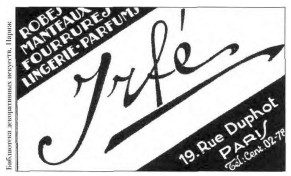
An advertisement for the house of
Irfe from Vogue magazine, Paris, 1925.
Felix Youssoupoff, the hero of our narrative, inherited from him all these properties and passions except the last one. Prince Felix Felixovich Youssoupoff, Count Sumarokov-Elston was born in the Youssoupoff palace on the Moika Canal in St. Petersburg on March 24, 1887. He realized very early in life that he was the owner of an immense fortune and was closely linked to the noble families of the Russian and European aristocracies. His mother, Princess Zinaida Nikolayevna Youssoupoff, was a woman of rare beauty and exquisite manners. When Felix was born, she had been expecting a girl and had prepared a layette in pink for the newborn. Felix was enchanted by his mother’s beauty and ardently worshiped her, delighting in her impeccable clothes and her legendary and fabulously expensive diamonds and pearls. In his memoirs, published in Paris, Felix Youssoupoff devotes much space to describing the luxurious dresses, sables, silks, and velvets that he saw in his youth. Another passion of his childhood that he retained in his adult years was his love of Eastern exotica; he often idiosyncratically played “the sultan.” The prince recalls: “Next to my father’s office was a Moorish hall that led out into the garden. Lavishly decorated with mosaics, it was the exact copy of the palace in the Alhambra: marble columns surrounding a central fountain couches upholstered in Persian fabrics lined the walls. I liked this room for its Oriental style, full of languor: I liked to give myself up to daydream there. Sitting on a couch with my mother’s jewels, I imagined myself a satrap surrounded by slaves.”1 Another experience of the prince that was to influence the house of Irfe’s exotic Eastern decor was the interior of the Youssoupoff estate in the Crimea; it was called Koccoz, which means “blue eye” in Tatar. It was a large and elegant palace, reminiscent of Bakhchisary. There were Turkish-style furniture, Turkish carpets, stained glass, and even a copy of the “fountain of love, the fountain of sorrow,” immortalized by Pushkin, completing the dreamy, voluptuous decor. High-concept Eastern dinners were arranged, and a wardrobe full of clothing in the Ottoman style was kept on hand for guests. All this excited young Felix’s passion for disguises, performances, and festivities. Neither fights with his parents nor embarrassing situations in the city could stop Felix from pursuing his inclinations—he liked to dress up. Friends of the Youssoupoff family once by chance saw him dressed in a women’s evening dress of silk tulle with silver sequins and a luxuriant headband of pale blue ostrich feathers, singing obscene couplets on the stage of the fashionable St. Petersburg coffeehouse “Aquarium.”
Felix recalls one such escapade in his memoirs: “That cold, icy night, a young woman in a ballroom gown, covered with diamonds, was racing at full speed in an open sleigh down the streets of St. Petersburg. Who would have recognized that this crazy woman was the son of one of the most venerable families in the city!”2 Felix not only liked to wear disguises himself, but often dressed up his favorite bulldog, Gugus, in amusing outfits, too. Once he even disguised himself as a wetnurse and Gugus as an infant whom he carried in his arms so he could smuggle him into England from Europe, undetected, in violation of the quarantine rule for cats and dogs. Felix’s trip to England in 1909-1910 and his “studies” at Oxford University were an unending series of pleasures and entertainments. The eccentric prince found steady amusement through his friendship with Anna Pavlova, Diaghilev’s triumphs in London, costume balls, and dinner parties. Fie was invited everywhere and his outrageous behavior become the sensation of the day. Felix recalls: “A little while later I received an invitation to a grand costume ball at Albert Hall. Since I still had some time to spare, I ordered a Russian costume of gold brocade with red flowers in the style of sixteenth-century St. Petersburg. The costume was magnificent: embroidered with gems and trimmed in sable, with a matching hat—it became a sensation. I met all of London at the soiree, and the next day my photograph figured prominently in all the newspapers.”3 As early as 1910, Felix Youssoupoff was one of the harbingers of the '"Russian style,” which was later to become so popular in Western Europe. Felix rented a large apartment near Hyde Park and skillfully decorated it. He liked black rugs, silk lampshades, soft furniture—in short, refined comfort. Prince Youssoupoff was probably the first of the Russian aristocrats to acquire what was at that time entirely new and unusual furniture from the Martin atelier, a subsidiary of the Parisian fashion house of Paul Poiret. Eccentric taste and extravagance always characterized Felix. After returning to Russia in 1912, Felix finally began thinking about the future. He was twenty-five years old, and the combination of a refined appearance with fabulous wealth and exquisite manners made him one of the most desirable eligible bachelors in prerevolutionary Russia, an enviable partner for many titled aristocrats. However, each time his notorious name was pronounced, excited whispers ensued. His overly close friendships with Grand Duke Dmitrii Pavlovich, the athlete Vasilii Soldatenkov, Eric Hamilton, Serbian Prince Pavel Karageorgievich and King Manuel of Portugal threw a shadow on Felix’s reputation.
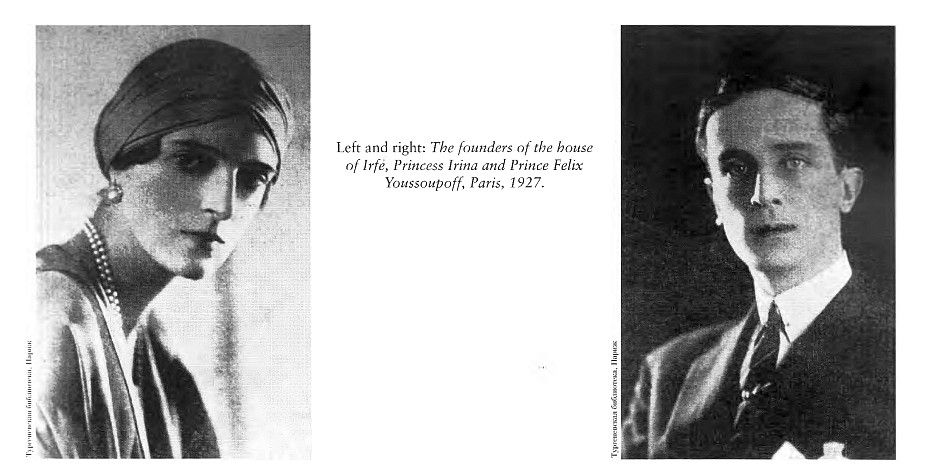
When young Youssoupoff’s choice for a bride fell on the Princess Irina Alexandrovna Romanova, it provoked a sea of talk and gossip. Prince Felix had met Princess Irina, the granddaughter of Emperor Alexander III, at the Youssoupoff estate Koccoz in the Crimea. A girl of innocence and incomparable beauty, Princess Irina was born on July 3, 1895, in Peterhof, the eldest daughter of Grand Duke Alexander Mikhailovich, the founder of the Russian Air Force and a childhood friend of Emperor Nicholas II. At the age of twenty-three, Alexander Mikhailovich fell in love with Nicholas IPs fourteen-year-old sister, Princess Xenia Alexandrovna. Despite the fact that the bride and groom were closely related (Xenia’s suitor was her father’s cousin), their union was not only happy, but exceptionally fruitful. In addition to the beautiful daughter Irina, there were six sons in the family, all of whom were saved from the revolution and continued the Romanov line in emigration. Felix recalls his first encounter with Irina Romanova: “From that day, I was sure that this was my fate. Since then, the adolescent had turned into a young woman of dazzling beauty. Shyness made her silent, but intensified her charm and surrounded her with mystery. Seized by a new feeling, I realized the poverty of my past adventures. I, too, had finally found that complete harmony which is the basis of every true love.”4 Felix and Irina’s wedding took place in the Anichkov Palace in St. Petersburg on February 22, 1914. The newlyweds moved into the left wing of the Youssoupoff palace on the Moika Canal, but soon after set off on a honeymoon voyage around Europe and the Near East. Upon the young couple’s return to Russia, Irina gave birth on March 21, 1915 to a daughter, also named Irina, the only child from the marriage. Felix’s future destiny was tragically and inextricably linked with the name of Grigory Rasputin, whose influence on the tsar and his family during World War I was, to the prince, unendurable. After thoroughly studying the habits and temperament of the “spiritual advisor,” Prince Youssoupoff made up his mind to take a step that forever inscribed his name in world history.
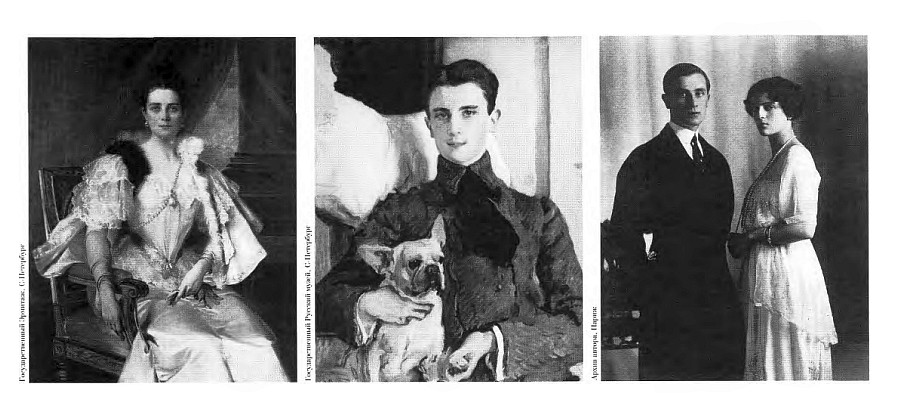
of Princess Zinaida Nikolayevna
Youssoupoff, 1894.
center: Valentin Serov, Portrait
of Prince Felix Youssoupoff, 1903.
right: Prince Felix and Princess
Irina. Youssoupoff at their wedding,
St. Petersburg, February 1914.
On Youssoupoff’s initiative, Grand Duke Dmitri Pavlovich, Purishkevich, Sukhotny, and Doctor Lazovert worked out a plan to miitder Rasputin in the basement of the Youssoupoff house. The events of that night, December 28, 1916, have been described in detail by both the conspirators themselves and historians. Felix Youssoupoff’s participation in Rasputin’s murder soon became a generally accepted fact. The prince and Irina were put under house arrest and sent to the Youssoupoff estate Rakitnoye while awaiting the investigation. Grand Duke Dmitrii Pavlovich was exiled to Persia, which saved his life during the revolution. In 1917 the Youssoupoffs moved to their estate Ai-Todor in the Crimea. Living out the last peaceful days in Russia, Felix made two trips back to St. Petersburg from the Crimea: the first one to retrieve two Rembrandt portraits, and the second to hide the family diamonds under the staircase of the house. The jewelry was discovered by workers doing repairs on the house in the mid1920s and was confiscated by the Bolsheviks. On April 13, 1919, when the evacuation of the Volunteer Army and the civilian population from the Crimea began under the onslaught of the Red Army, the couple accompanied the dowager Empress Maria Feodorovna and Irina’s brothers and mother, the Grand Duchess Xenia Alexandrovna, on the English dreadnought Marlborough— they were leaving Russia forever. At first, the Youssoupoffs lived comfortably in exile: they had a large villa in Italy, and Paris seemed to them a temporary romantic refuge. Trying to settle into a new life, the Youssoupoffs bought a small house in Boulogne, a southeastern suburb of Paris, where they later founded their fashion house, Irfe. Erte, who lived near them on rue Gutenberg and knew them intimately, recalls: “I first met the Youssoupoffs around 1921 at Ganna Walska’s house in Paris. What a handsome couple they were! The Prince had been regarded as one of the best-looking men in Russia. Even in old age his finely structured face, though wrinkled, was still striking. He had a wry sense of humour. In reminiscing about his life in Russia, he once said to me, ‘I married my wife out of snobbery. My wife married me for money —a not-so-subtle reminder of the fact that the Youssoupoffs had once been the richest family in Russia, much richer than his wife’s family, the Romanoffs.”5 This candid admission may well explain their somewhat surprising marriage. We should not forget, however, that the Youssoupoffs did live a long and difficult life together, filled with love and mutual understanding. Erte writes: “When the Youssoupoffs finally left Russia in April 1919 on the British dreadnought Marlborough, they were able to bring out many valuables—paintings, furniture, decor, and art. The proceeds from their sale supported them for many years, making it possible for them to live in, if not imperial, then relative, luxury. In addition to an estate in Corsica, they had a house with a large garden near the Parc de Prince in Boulogne-sur-Seine not far from my apartment. The prince had a wing added to the house, in which he created a charming theater. The walls were decorated with murals by the famous Russian painter Yakovlev. This house was destroyed several years ago in order to free the space for a large apartment house. My heart broke when I saw the empty lot, strewn with the shards of these remarkable murals.”6 Photographs of the interior Youssoupoff and Yakovlev created were published in one of the unique books of the 1920s about fashion houses. The Youssoupoff house comprised stylish furniture, silk lampshades, a large fireplace, and murals on the walls with figures in perspective in the spirit of the Italian quattrocento. The prince came up with a creative touch: a small, intimate theater with a decorative curtain for fashion shows and at-home concerts—a distant relative of the luxurious theater at the Youssoupoff house in St. Petersburg. Princess Tatyana Metternich, who attended this theater in her childhood, writes: “The Youssoupoffs always had theaters in their palaces. For them it was a normal thing.
They constructed and decorated their theater in Boulogne with their artist friend Alexander Yakovlev. There were gracefully arranged odalisques all along the walls, painted in cream, beige and pale green shades in Art Nouveau style. The theater itself was carpeted and shaped like an oval salon, with a curtain and a small staircase in the middle separating it from the stage.”7 Prince Youssoupoff writes in his memoirs that the idea to open his own fashion house arose when he and his wife returned from a trip to the United States in 1924. Irfe was started modestly: together with a group of Russian friends, the Youssoupoffs rented a building on rue Obligado. This is where the first designs were cut and sewn. Prince Youssoupoff recalled that a Russian emigre woman, an eccentric creator of designs that were beautiful but difficult to wear, worked as his cutter. Not knowing how to proceed in this new business, the Yousoupoffs launched their first collection without the necessary advertising. Happily, a new occasion to prove themselves presented itself rather quickly. A few months later, in the winter of 1924, there was a fashion show by the big Parisian houses at the Hotel Ritz on the Place Vendome, which ended with a ball. The Irfe atelier was furiously working late into the night: the last designs were still being sewn as the Irfe models arrived at the Ritz well after midnight with the ravishing Irina in the lead. It created an indelible impression even on the jaded Parisian public, who had seen it all. A French reporter wrote: “Originality, refined taste, meticulous work and an artistic sense of color immediately placed this modest atelier in the ranks of the big houses of fashion.”8 Encouraged by these first signs of recognition, Felix and Irina Youssoupoff organized showings at their home in the theater wing. In those years, when Rasputin’s murder was still fresh in people’s minds, the opportunity to dress elegantly at the fashion house of “the very same” Prince Youssoupoff appealed to the imagination of snobbish European and American clients. Irfe’s success exceeded all expectations, and the Youssoupoffs rented a new building, more advantageously located—in the center of Paris near the grand boulevards, Place de la Concorde, and rue de la Paix, where most of the large fashion houses were found— which bolstered Irfe’s reputation.
The building in which the Youssoupoffs continued their business, on rue Duphot, still stands today. They occupied the first floor of an old-style house, and the prince had the entire interior renovated. The wood paneling was painted a light gray, the walls covered in gray velvet. The reception room, as was the custom in all decent houses in Russia, was furnished in mahogany furniture, its walls covered in gray floral cretonne. There were yellow silk drapes on the windows and, to create a feeling of coziness, antique engravings and showcases for family knick-knacks were brought in. The elegant decor was completed with several touches in Irina Youssoupoff’s style, such as unusually shaped crystal bottles and Irfe embroidered shawls draped casually on the backs of armchairs, as if the mistress had left them there by chance. From 1925 on, virtually the entire staff of Irfe consisted of Russian emigres. In addition to the Youssoupoffs, Irina’s twenty-five-year-old brother, Prince Nikita Alexandrovich Romanov, and his wife, Princess Maria Illarionovna Romanovskaya, nee Countess Vorontzova-Dachkova, worked there. Mikhail and Nonna Kalashnikov took an active part in the organization of the business.
To be continued…
